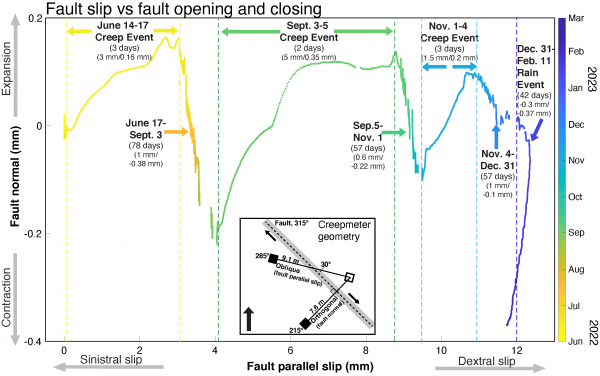Small-scale propagation of shallow creep events and environmental effects on the San Andreas fault, central California
Heather Crume
California Geological Survey

- Date & Time
- Location
- Online-only seminar via Microsoft Teams
- Host
- Curtis Baden
- Summary
Surface creep has been documented on the San Andreas fault (SAF) since the 1960s. From Parkfield in the southeast to San Juan Bautista (SJB) in the northwest, the SAF is largely creeping and accommodating most of the ~38 mm/year right-lateral plate motion. The SJB section of the SAF lies at the northwest boundary of the central creeping section, forming a creeping-to-locked transition. These transition sections are known to be potential zones for earthquake nucleation. Spatiotemporal changes in fault creep within this locking transition provide a potential quantitative measure for the assessment of the seismic hazard of the SAF system in the region. In addition to steady fault creep, episodic creep events characterized by accelerated slip of a few millimeters to centimeters over several days occur. However, knowledge of the along-strike and downdip-extent and propagation velocity of these events is limited by the sparse density of current creepmeters. How do these events propagate? What is their magnitude? What factors drive their occurrence? Moreover, there is a need to address environmental effects that can confound creep data and develop appropriate corrections. To address some of these questions, we have initiated a densification of the current creepmeter array by installing new instruments and renovating those in disrepair. We report results from some of these sensors. At Fox Creek, south of Hollister, we installed two creepmeters 130 m apart to measure creep event propagation velocity. One was equipped with an orthogonal sensor to measure dilation. During the dry season ≈0.16-0.35 mm of fault dilation accompanied complex creep event sequences with cumulative amplitudes of 3.5-5.8 mm. In the months following each sequence the fault zone slowly returned to its pre-event width. During one creep event a southward propagating dislocation was present with a velocity of 0.4 km/hour. We also observe distinct differences in amplitude and shape of creep events. Further, we are able to correct for apparent left-lateral slip due to fault closing during a rain event using the relationship between the orthogonal and oblique instruments.
Closed captions are typically available a few days after the seminar. To turn them on, press the ‘CC’ button on the video player. For older seminars that don’t have closed captions, please email us, and we will do our best to accommodate your request.
 Jump to Navigation
Jump to Navigation